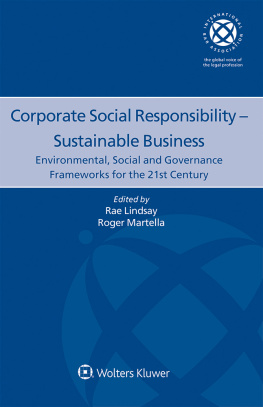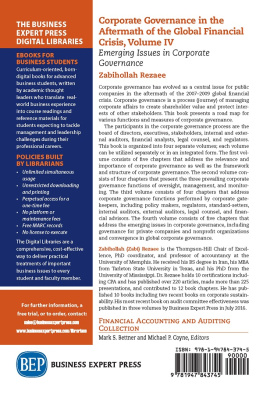In the preparation of this book I am indebted to the following people. To Lawrence Mitchell for his generosity in writing the foreword to this book. The staff at Routledge for their professionalism and patience, my two sterling research assistants, Rahul Worah and Jamal Tuhin, for their work on the footnotes, and to Jamal for his work on the corporate governance codes and index. I am also indebted to my colleagues at Warwick for their contributions to a vibrant research culture, and particularly to Julio Faundez for his wisdom and guidance at Warwick. On a more personal level I am indebted to my talented mother for the beautiful picture on the front cover, to both my parents for being so nice and to my children Jasmine, Jago and Felix for being simply glorious. Most of all, though, I am indebted to my husband Richard, who has commented extensively on early drafts of the book, cheerfully engaged in discussions about the book and looked after our children so I could write the book. This book is dedicated to his unwavering love and support.
Preamble. On how Adam Smiths economic and social theories dominated thinking on the economy throughout the late 18th century up until the latter part of the 19th century. How his labour theory of value did not seek progressive normative voice in policy. How instead investor entitlement was promoted. How the judiciary and the government were divided on the issue in the early 19th century. How the Bubble Act encouraged a proliferation of unincorporated associations acting as a vehicle for outside investment and how the judiciary subsequently utilised the Act to stop large unincorporated associations selling freely transferable shares. How parliament responded by repealing the Bubble Act in 1825 and passed a number of Company Acts to accommodate outside investors including the Limited Liability Act 1855 and the Companies Act 1867. How manufacturing businesses eschewed this legislation and continued to operate as partnerships or as quasi-partnership companies that retained large uncalled capital. How overproduction and global competition forced down prices and how British capitalists responded with business mergers to reduce competition. How in so doing they finally embraced the legal structure of the company originally introduced to facilitate investor capitalism and to protect investor capitalists. How the use of the corporate form individualised roles in production as shareholders (with limited liability), directors and workers which obfuscated the underlying dynamics of production and profit and the key role of labour in making profit.
Introduction
From the late 18th century and the work of Adam Smith until the last quarter of the 19th century labour was understood to be the source of value creation and capitalism to be a particular and efficient way of organising and extracting that value. Later in the 19th century an intellectual schism occurred in which the alternative market price conceptualisation of the economy, or neoclassical economics came to dominate mainstream thought, relegating labour to a cost of production. The labour theory of value, widely held by economists at the time, originates with Adam Smith and ends with Karl Marx. The economy in which Smith was writing was one which was highly labour intensive; companies were a rarity and unincorporated associations were the most common way to organise business. The economy in which Marx was latterly writing was more industrialised and companies were more frequently utilised. However, although Marx was writing in the context of a more developed market economy than Smith his work anticipates future developments such as the increasing tendency for companies to grow in size and for the role of management to be separated from control.
This period is also characterised by a disjuncture between economic views and normative values. Smith believed labour to be the source of value but did not support labours claim to a greater portion of the wealth they created. Indeed, Smiths chief criticism of slavery was that it was an inefficient way of exploiting labour. Benthams The Principles of Morals and Legislation published in 1789 provided an alternative way to view the value of commodities which did not posit labour as the source of value. Despite this, his normative position was more egalitarian and progressive in that he sought to produce social outcomes that created the greatest happiness for all. Mills development of Benthams approach similarly rejected labour as the source of value but adopted a normative position, which likewise prioritised societys best interest. At heart, Bentham and Mill focused on the usefulness of production and indeed of social action per se for members of a society. In assessing the value of a commodity they asked: how is this value positively experienced by the individual who buys and enjoys it? With this approach they shifted the focus of value away from the inherent value of embodied labour, to the utility of a commodity as experienced by the individual.
For Bentham the states role in reform and the law was properly to calculate how best to increase this positive experience for all individuals. In contrast, for Mill, the role of the state was to facilitate individual liberty so that the individual could choose his own experience and that which may make him happy. So for Mill, the value of a commodity is determined by the preference of the buyer in a free economy where the states role was to ensure that freedom. Political liberty, which was the more profound intention of Mills work, must necessarily find expression in economic liberty, or freedom from state interference. Mills economic liberty found voice in the successful campaign against the Corn Laws and in Cobdens less successful campaign for national and international free trade. In the context of business organisations, the idea of economic liberty found voice in the government instigated legal reconceptualisation of the company as a private organisation to which the state devolved legal and economic power. Indeed, Mills work anticipates the micro-economic theory based on price or neoclassical economics.
Neoclassical economics informs our contemporary understanding of economic behaviour and, by extension, the governance and role of the company. It became the mainstream interpretation of the economy and the company from around the last quarter of the 19th century. And, aside from a short period from the 1930s to the 1970s when institutional economics dominated it has remained so. Labour theory economics fell from mainstream thought on the economy and the company with the success of the neoclassical model. It was never, however, a theory that resulted in privileging labour in the governance of companies because the exploitation of labour was seen as necessary for economic growth. However, by placing labour at the centre of production it is a theory that has potential to provide a humanistic and progressive model. Thus Marx translated the theory of labour value into a normative position which aimed to elevate the position of workers. In this, it correlates with the neoliberal claim of investor entitlement to corporate governance goals based on the assumption that investment creates value.
The purpose of this chapter is to examine the development of company law and corporate governance from the late 18th century to the early 19th century in the context of economic developments and the dominant economic theories of the time. Following this introduction, in the first section I assess the role of the South Sea Companys collapse in facilitating the rise of private unincorporated associations acting as corporations without the control of a charter. In the second section I examine Smiths assessment of corporations and his theory that labour was the source of productive value. In the third section I assess the judiciarys condemnation of unincorporated associations who were acting like corporations. It examines the courts use of the Bubble Act to thwart the activities of associations as investment vehicles and parliaments pro-investor legislative response. In the fourth section I examine the emergence of laissez-faire economics, which was galvanised by the repeal of the Corn Law and henceforth determined company law. In the fifth section I examine the pro-investor legislation passed by the government from 18551867 and how company law encapsulated a laissez-faire approach by constructing a legal environment in which all company players from investors to creditors were charged with weighing up their personal risk in dealing with a limited liability company. In the final section the effects of the Great Depression are assessed in order to show that the shift by manufacturing industry from operating as partnerships to operating as large companies was prompted by economic failure. The chapter concludes with an assessment of Marxs project to reassert labour as the source of value in the context of an increasingly financialised economy.









